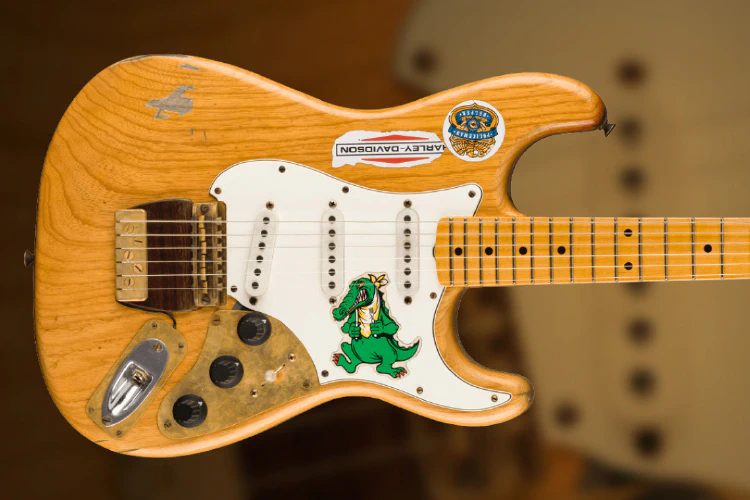Store-bought Strat Becomes Counter-culture Legend
The Dead were gear obsessives from the start, and their breakthroughs in live sound would eventually change the business. The Dead were founded in the back room of a music store in Palo Alto in 1965. By the time Nash gave Garcia the Strat, the band had already established their own auxiliary company, the still-running Alembic, for the manufacture of instruments and gear. The technicians at Alembic experimented frequently under the direction of former LSD chemist and Dead sound expert Owsley Stanley, and Garcia’s Strat frequently appeared on the Alembic workbench.
The only changes made to the Strat before it made its stage debut in the summer of 1971 were new Raytheon volume knobs. First and foremost, the instrument had to be roadworthy for Garcia, who in the early ’70s performed at bars almost every night the Dead were off. Garcia’s former roadie Steve Parish wrote in his autobiography, Home Before Daylight, of a night in Buffalo during his first tour as a solo artist when “it was so cold that when Jerry came out on stage and strummed his ‘Alligator,’ the face plate of the guitar shattered and the guts popped out. That was how the program started. Gaffer’s tape was used to patch up Alligator, and at the end of the tour, a new brass plate was installed.
Garcia embellished the guitar’s body with several stickers later that year, including the pickguard’s grinning cartoon alligator that gave the instrument its name. But by that point, Alembic technician Frank Fuller had reworked almost every other component of the instrument in a succession of improvements.
The guitar was designed by Deadheads (who have also constructed replica Alligators), and it underwent a serious customization process that included, but was not limited to, new Schaller tuning pegs and gears, a number of bridges (including an Alembic custom and a Gibson ABR-1 Tune-o-Matic), a new control plate (hammered brass), taller frets, and an in-board post-volume “blaster.” One comprehensive history of the guitar mentions, “Each pickup cover had its own separately grounded wire.”
On the band’s first comprehensive European tour with Garcia on the guitar, the band’s thick 1960s psychedelic crunch gives way to a more barn-storming sound influenced by Don Rich, the guitarist for country singer Buck Owens and one of the creators of the Bakersfield Sound. The Strat’s newest modifications included the Alembic blaster (wired into always-on position) and its first two stickers, an R. Crumb “Keep on Truckin'” and a Harley-Davidson logo, all of which could be seen (or heard) in various videos of the legendary tour. These songs were added to by a fresh batch of songs co-written with lyricist Robert Hunter that continued the duo’s explorations of a surreal Americana.
The “Frankenstein,” as Alembic’s Ron Turner and Frank Fuller dubbed it, played its final gig on Garcia’s 30th birthday—August 1st, 1973—in Jersey City, NJ, occasionally switching out for other Strats later in 1972 and early in 1973. Naturally recorded by Deadheads, Alligator was sent off with a cosmic 25-minute “Dark Star.” One of the few components of Alligator that was left unchanged when Garcia started performing with “Wolf” in the fall of that year were Fender single coil pickups (and stock Strat wiring). Although many fantastic jams would come after, Garcia’s first heavily modified guitar, Alligator, gave it its teeth.
v
